ECO mode FORD KUGA 2011 1.G Workshop Manual
[x] Cancel search | Manufacturer: FORD, Model Year: 2011, Model line: KUGA, Model: FORD KUGA 2011 1.GPages: 2057
Page 10 of 2057
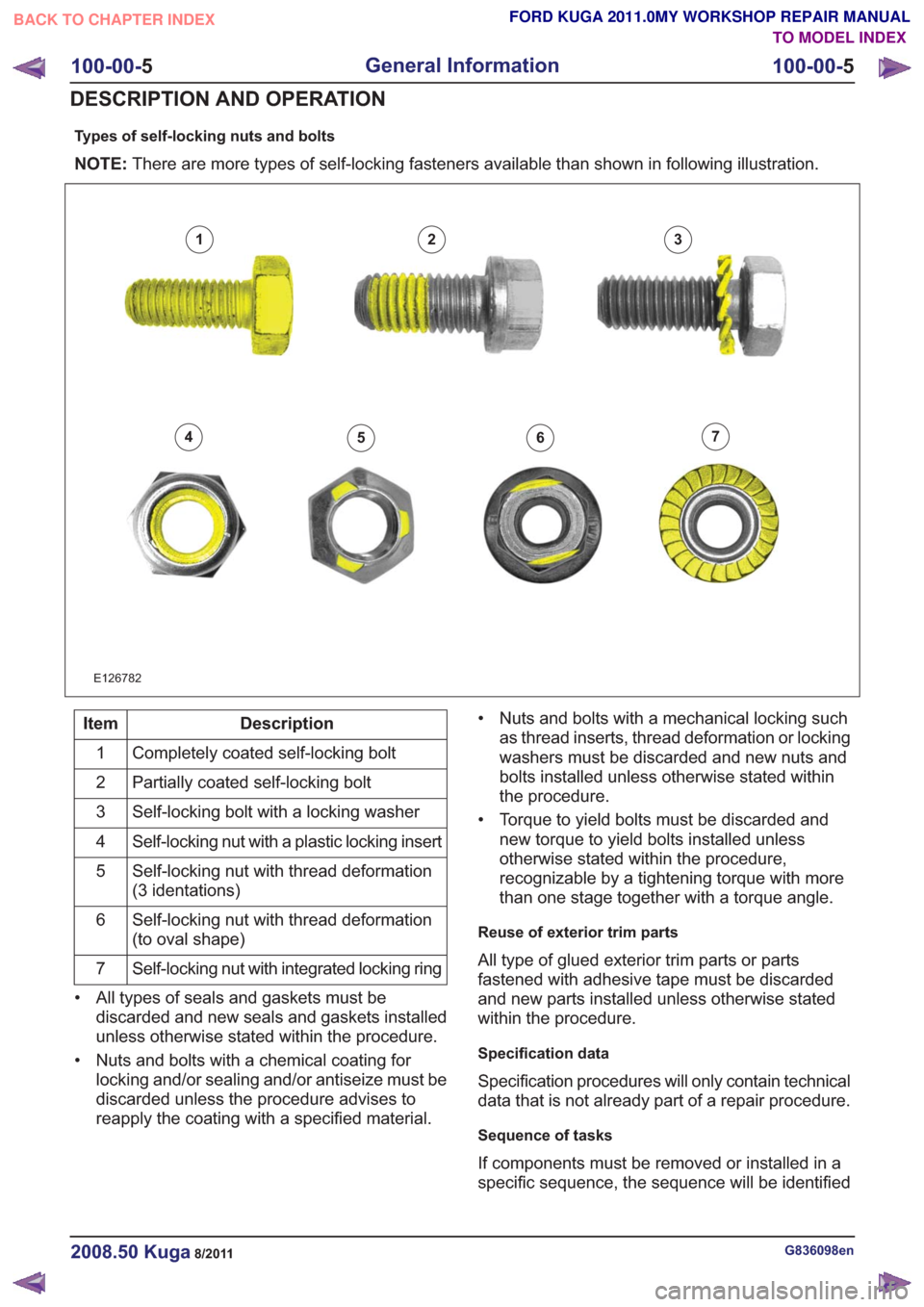
Types of self-locking nuts and bolts
NOTE:There are more types of self-locking fasteners available than shown in following illustration.
E126782
123
4567
Description
Item
Completely coated self-locking bolt
1
Partially coated self-locking bolt
2
Self-locking bolt with a locking washer
3
Self-locking nut with a plastic locking insert
4
Self-locking nut with thread deformation
(3 identations)
5
Self-locking nut with thread deformation
(to oval shape)
6
Self-locking nut with integrated locking ring
7
• All types of seals and gaskets must be discarded and new seals and gaskets installed
unless otherwise stated within the procedure.
• Nuts and bolts with a chemical coating for locking and/or sealing and/or antiseize must be
discarded unless the procedure advises to
reapply the coating with a specified material. • Nuts and bolts with a mechanical locking such
as thread inserts, thread deformation or locking
washers must be discarded and new nuts and
bolts installed unless otherwise stated within
the procedure.
• Torque to yield bolts must be discarded and new torque to yield bolts installed unless
otherwise stated within the procedure,
recognizable by a tightening torque with more
than one stage together with a torque angle.
Reuse of exterior trim parts
All type of glued exterior trim parts or parts
fastened with adhesive tape must be discarded
and new parts installed unless otherwise stated
within the procedure.
Specification data
Specification procedures will only contain technical
data that is not already part of a repair procedure.
Sequence of tasks
If components must be removed or installed in a
specific sequence, the sequence will be identified
G836098en2008.50 Kuga8/2011
100-00- 5
General Information
100-00- 5
DESCRIPTION AND OPERATION
TO MODEL INDEX
BACK TO CHAPTER INDEX
FORD KUGA 2011.0MY WORKSHOP REPAIR MANUAL
Page 15 of 2057
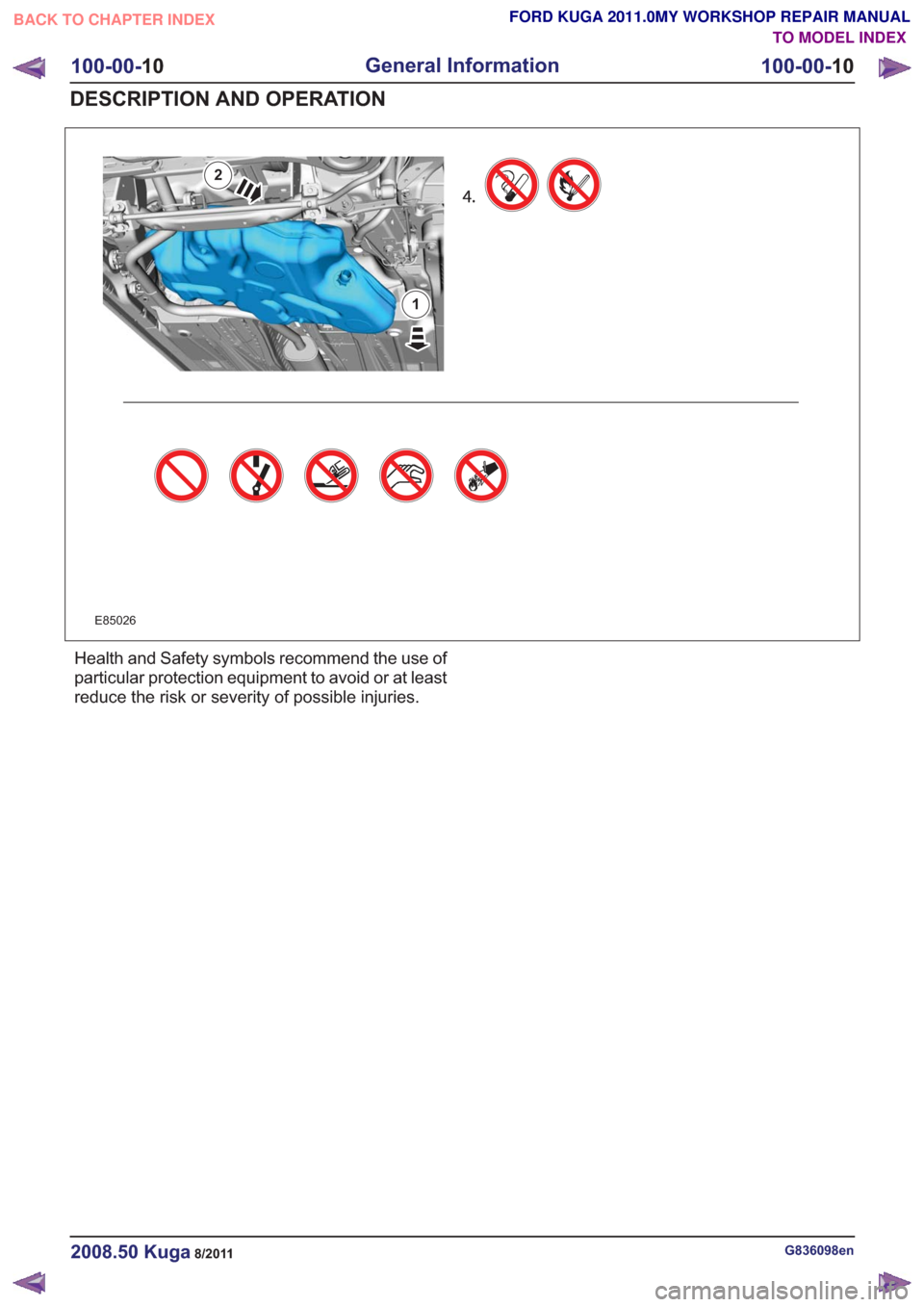
1
2
1
2
E85026
Health and Safety symbols recommend the use of
particular protection equipment to avoid or at least
reduce the risk or severity of possible injuries.
G836098en2008.50 Kuga8/2011
100-00-10
General Information
100-00- 10
DESCRIPTION AND OPERATION
TO MODEL INDEX
BACK TO CHAPTER INDEX
FORD KUGA 2011.0MY WORKSHOP REPAIR MANUAL
Page 21 of 2057

Standard tool symbols recommend the use of
certain standard tools. These tools can includedimension values if required.
E84839
The following graphic illustrates a set of symbols
that are used to provide detailed information on
where to apply a material.
G836098en2008.50 Kuga8/2011
100-00-
16
General Information
100-00- 16
DESCRIPTION AND OPERATION
TO MODEL INDEX
BACK TO CHAPTER INDEX
FORD KUGA 2011.0MY WORKSHOP REPAIR MANUAL
Page 28 of 2057
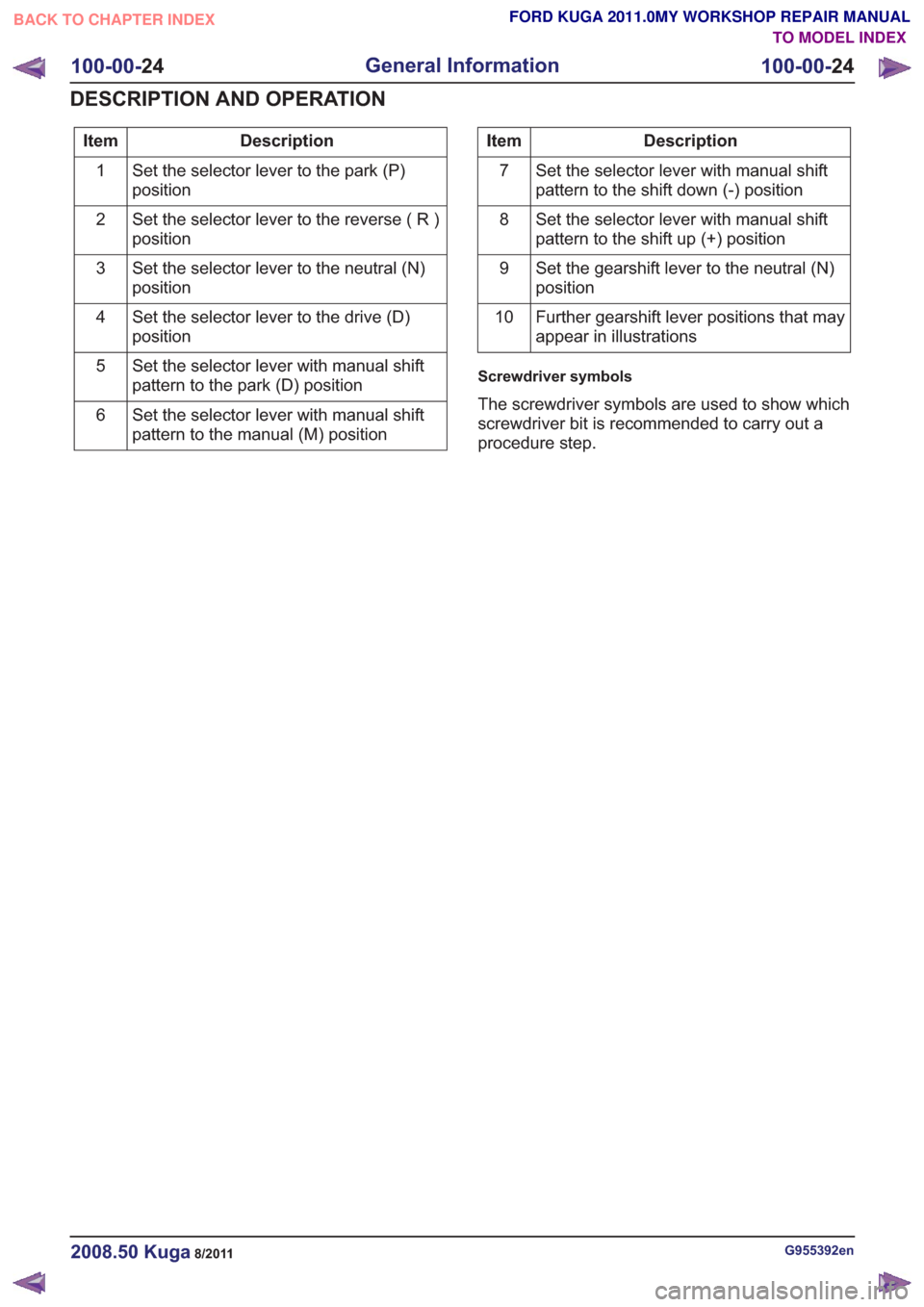
Description
Item
Set the selector lever to the park (P)
position
1
Set the selector lever to the reverse ( R )
position
2
Set the selector lever to the neutral (N)
position
3
Set the selector lever to the drive (D)
position
4
Set the selector lever with manual shift
pattern to the park (D) position
5
Set the selector lever with manual shift
pattern to the manual (M) position
6Description
Item
Set the selector lever with manual shift
pattern to the shift down (-) position
7
Set the selector lever with manual shift
pattern to the shift up (+) position
8
Set the gearshift lever to the neutral (N)
position
9
Further gearshift lever positions that may
appear in illustrations
10
Screwdriver symbols
The screwdriver symbols are used to show which
screwdriver bit is recommended to carry out a
procedure step.
G955392en2008.50 Kuga8/2011
100-00-
24
General Information
100-00- 24
DESCRIPTION AND OPERATION
TO MODEL INDEX
BACK TO CHAPTER INDEX
FORD KUGA 2011.0MY WORKSHOP REPAIR MANUAL
Page 30 of 2057

E88973
1
3
4
5
2
Description
Item
Screwdriver
1
Cross bladed screwdriver
2
Flat bladed screwdriver
3Description
Item
Hexagonal screwdriver
4
TORX screwdriver
5
Pliers symbols
The pliers symbols are used to show which pliers
is recommended to carry out a procedure step.
G955392en2008.50 Kuga8/2011
100-00- 25
General Information
100-00- 25
DESCRIPTION AND OPERATION
TO MODEL INDEX
BACK TO CHAPTER INDEX
FORD KUGA 2011.0MY WORKSHOP REPAIR MANUAL
Page 32 of 2057
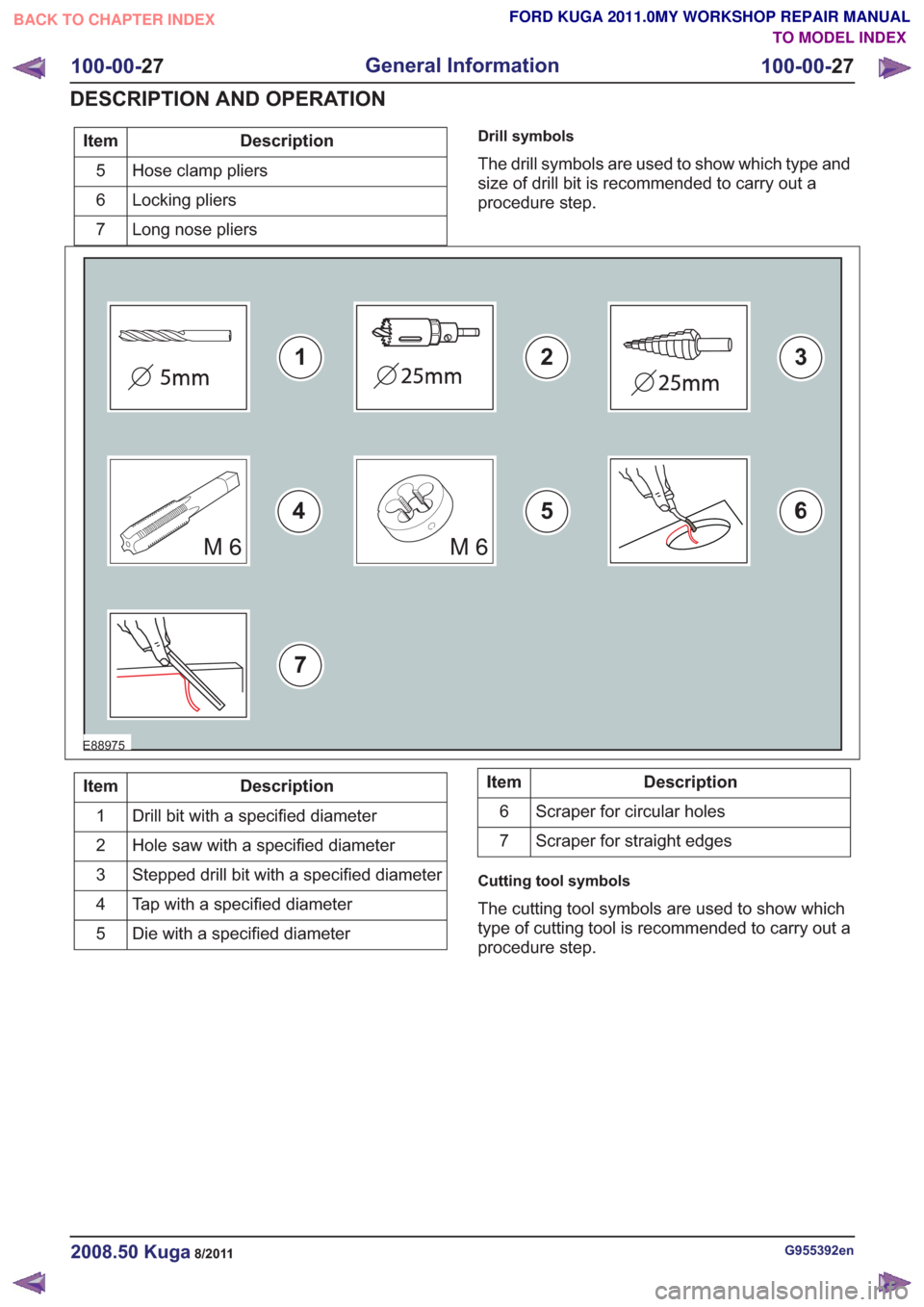
Description
Item
Hose clamp pliers
5
Locking pliers
6
Long nose pliers
7Drill symbols
The drill symbols are used to show which type and
size of drill bit is recommended to carry out a
procedure step.
123
45
E88975
M6M6
Description
Item
Drill bit with a specified diameter
1
Hole saw with a specified diameter
2
Stepped drill bit with a specified diameter
3
Tap with a specified diameter
4
Die with a specified diameter
5Description
Item
Scraper for circular holes
6
Scraper for straight edges
7
Cutting tool symbols
The cutting tool symbols are used to show which
type of cutting tool is recommended to carry out a
procedure step.
G955392en2008.50 Kuga8/2011
100-00- 27
General Information
100-00- 27
DESCRIPTION AND OPERATION
TO MODEL INDEX
BACK TO CHAPTER INDEX
FORD KUGA 2011.0MY WORKSHOP REPAIR MANUAL
Page 48 of 2057

Health and Safety Precautions
Introduction
Many of the procedures associated with vehicle
maintenance and repair involve physical hazards
or other risks to health. This subsection lists,
alphabetically, some of these hazardous operations
and the materials and equipment associated with
them. Precautions necessary to avoid these
hazards are identified.
The list is not exhaustive and all operations and
procedures, and the handling of materials, should
be carried out with health and safety in mind.
Before using any product the Materials Safety Data
Sheet supplied by the manufacturer or supplier
should be consulted.
Acids and Alkalis
See alsoBattery Acids.
For example caustic soda, sulphuric acid.
Used in batteries and cleaning materials.
Irritant and corrosive to the skin, eyes, nose and
throat. Cause burns. Can destroy ordinary
protective clothing.
Avoid splashes to the skin, eyes and clothing. Wear
suitable protective impervious apron, gloves and
goggles. Do not breath mists.
Make sure access to eye wash bottles, shower and
soap are readily available for splashing accidents.
Display Eye Hazard sign.
Air Bags
See also Fire, Chemical Materials.
Highly flammable, explosive – observe No Smoking
policy.
Used as a safety restraint system mounted in the
steering wheel and passenger side of the
instrument panel.
The inflator contains a high-energetic propellant
which, when ignited, produces a VERY HOT GAS
(2500°C).
The gas generant used in air bags is Sodium Azide.
This material is hermetically sealed in the module
and is completely consumed during deployment.
No attempt should be made to open an air bag inflator as this will lead to the risk of exposure to
Sodium Azide. If a gas generator is ruptured, full
protective clothing should be worn when dealing
with the spillage.
After normal deployment, gloves and safety
goggles must be worn during the handling process.
Deployed air bags should be disposed of in a
plastic bag in accordance with local regulations at
an approved chemical waste site.
For additional information, refer to:
Supplemental
Restraint System (SRS) Health and Safety
Precautions (100-00 General Information,
Description and Operation).
Air Conditioning Refrigerant
See also Chlorofluorocarbon, Chemical Materials
Highly flammable, combustible – observe No
Smoking policy.
Skin contact may result in frostbite.
Instructions given by the manufacturer must be
followed. Avoid naked lights, wear suitable
protective gloves and goggles.
If refrigerant comes into contact with the skin or
eyes, immediately rinse the affected areas with
water. Eyes should also be rinsed with an
appropriate irrigation solution and should not be
rubbed. SEEK MEDICAL ASSISTANCE IF
NECESSARY.
For additional information, refer to: Air Conditioning
(A/C) System Health and Safety Precautions
(100-00 General Information, Description and
Operation).
Adhesives and Sealers
See also Fire, Chemical Materials.
Highly flammable, flammable, combustible –
observe No Smoking policy.
Generally should be stored in No Smoking areas.
Cleanliness and tidiness in use should be
observed, for example disposable paper covering
benches; should be dispensed from applicators
where possible; containers, including secondary
containers, should be labeled appropriately.
G566527en2008.50 Kuga8/2011
100-00- 42
General Information
100-00- 42
DESCRIPTION AND OPERATION
TO MODEL INDEX
BACK TO CHAPTER INDEX
FORD KUGA 2011.0MY WORKSHOP REPAIR MANUAL
Page 51 of 2057
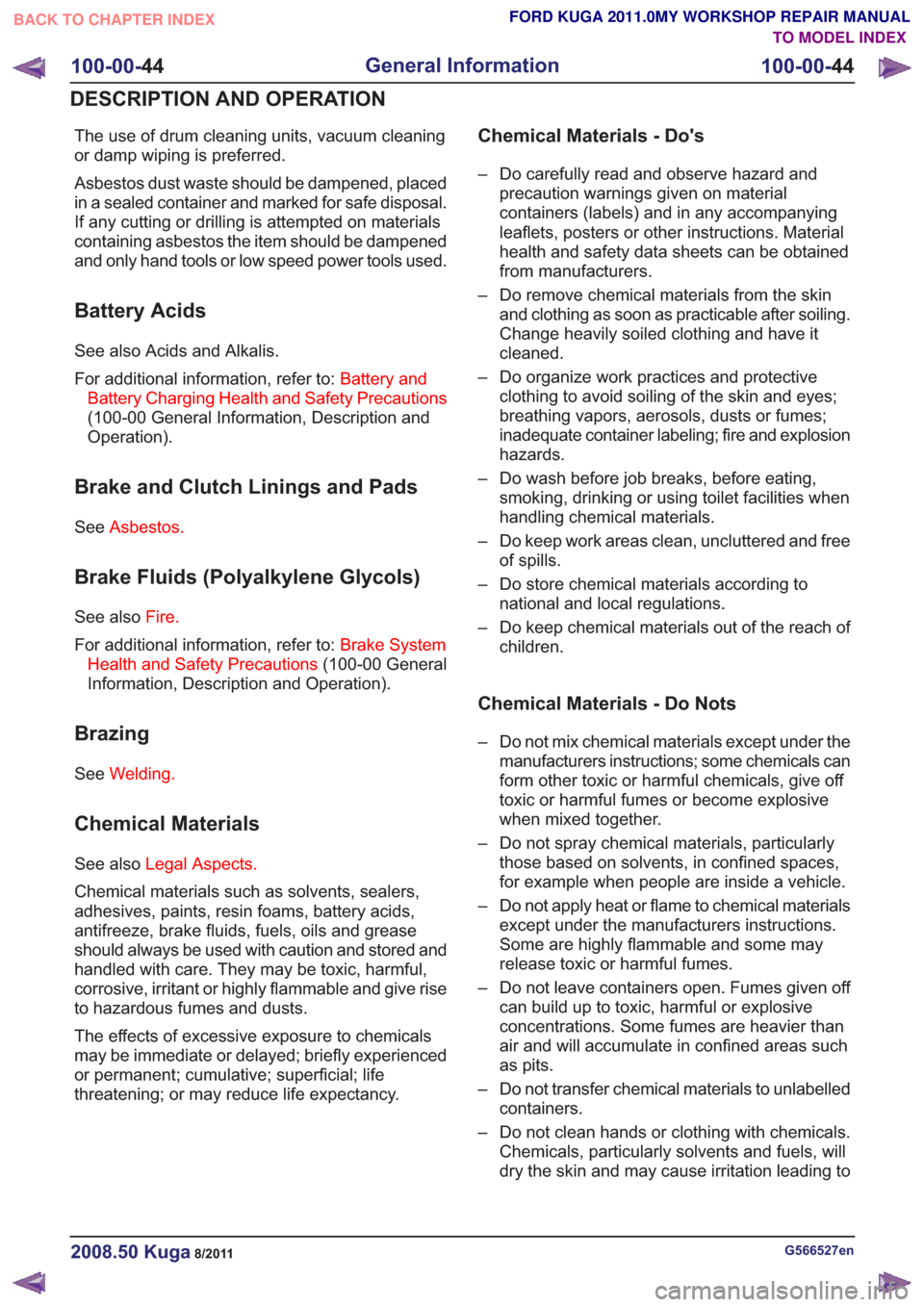
The use of drum cleaning units, vacuum cleaning
or damp wiping is preferred.
Asbestos dust waste should be dampened, placed
in a sealed container and marked for safe disposal.
If any cutting or drilling is attempted on materials
containing asbestos the item should be dampened
and only hand tools or low speed power tools used.
Battery Acids
See also Acids and Alkalis.
For additional information, refer to:Battery and
Battery Charging Health and Safety Precautions
(100-00 General Information, Description and
Operation).
Brake and Clutch Linings and Pads
See Asbestos.
Brake Fluids (Polyalkylene Glycols)
See also Fire.
For additional information, refer to: Brake System
Health and Safety Precautions (100-00 General
Information, Description and Operation).
Brazing
See Welding.
Chemical Materials
See also Legal Aspects.
Chemical materials such as solvents, sealers,
adhesives, paints, resin foams, battery acids,
antifreeze, brake fluids, fuels, oils and grease
should always be used with caution and stored and
handled with care. They may be toxic, harmful,
corrosive, irritant or highly flammable and give rise
to hazardous fumes and dusts.
The effects of excessive exposure to chemicals
may be immediate or delayed; briefly experienced
or permanent; cumulative; superficial; life
threatening; or may reduce life expectancy.
Chemical Materials - Do's
– Do carefully read and observe hazard and precaution warnings given on material
containers (labels) and in any accompanying
leaflets, posters or other instructions. Material
health and safety data sheets can be obtained
from manufacturers.
– Do remove chemical materials from the skin and clothing as soon as practicable after soiling.
Change heavily soiled clothing and have it
cleaned.
– Do organize work practices and protective clothing to avoid soiling of the skin and eyes;
breathing vapors, aerosols, dusts or fumes;
inadequate container labeling; fire and explosion
hazards.
– Do wash before job breaks, before eating, smoking, drinking or using toilet facilities when
handling chemical materials.
– Do keep work areas clean, uncluttered and free of spills.
– Do store chemical materials according to national and local regulations.
– Do keep chemical materials out of the reach of children.
Chemical Materials - Do Nots
– Do not mix chemical materials except under themanufacturers instructions; some chemicals can
form other toxic or harmful chemicals, give off
toxic or harmful fumes or become explosive
when mixed together.
– Do not spray chemical materials, particularly those based on solvents, in confined spaces,
for example when people are inside a vehicle.
– Do not apply heat or flame to chemical materials except under the manufacturers instructions.
Some are highly flammable and some may
release toxic or harmful fumes.
– Do not leave containers open. Fumes given off can build up to toxic, harmful or explosive
concentrations. Some fumes are heavier than
air and will accumulate in confined areas such
as pits.
– Do not transfer chemical materials to unlabelled containers.
– Do not clean hands or clothing with chemicals. Chemicals, particularly solvents and fuels, will
dry the skin and may cause irritation leading to
G566527en2008.50 Kuga8/2011
100-00- 44
General Information
100-00- 44
DESCRIPTION AND OPERATION
TO MODEL INDEX
BACK TO CHAPTER INDEX
FORD KUGA 2011.0MY WORKSHOP REPAIR MANUAL
Page 53 of 2057
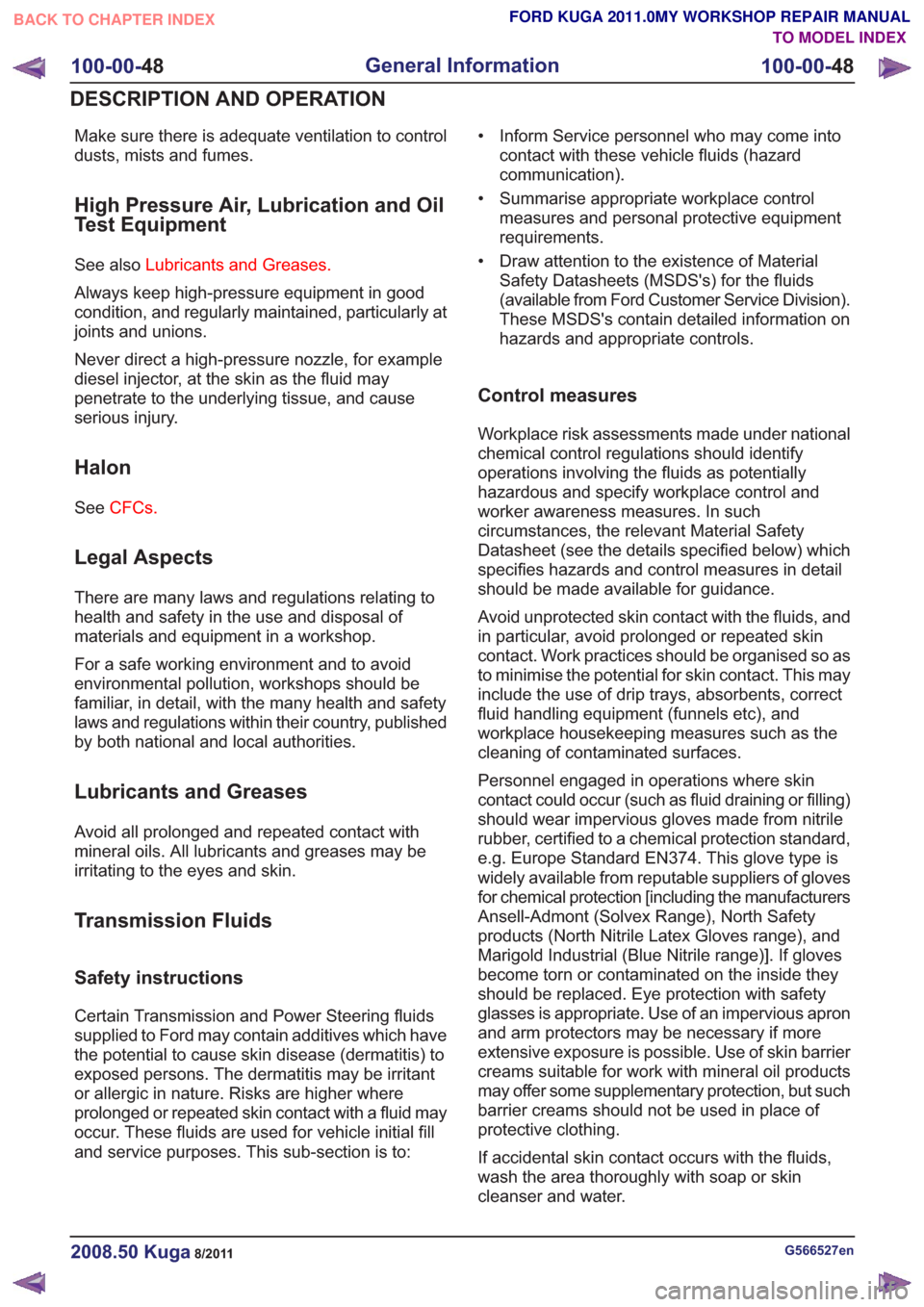
Make sure there is adequate ventilation to control
dusts, mists and fumes.
High Pressure Air, Lubrication and Oil
Test Equipment
See alsoLubricants and Greases.
Always keep high-pressure equipment in good
condition, and regularly maintained, particularly at
joints and unions.
Never direct a high-pressure nozzle, for example
diesel injector, at the skin as the fluid may
penetrate to the underlying tissue, and cause
serious injury.
Halon
See CFCs.
Legal Aspects
There are many laws and regulations relating to
health and safety in the use and disposal of
materials and equipment in a workshop.
For a safe working environment and to avoid
environmental pollution, workshops should be
familiar, in detail, with the many health and safety
laws and regulations within their country, published
by both national and local authorities.
Lubricants and Greases
Avoid all prolonged and repeated contact with
mineral oils. All lubricants and greases may be
irritating to the eyes and skin.
Transmission Fluids
Safety instructions
Certain Transmission and Power Steering fluids
supplied to Ford may contain additives which have
the potential to cause skin disease (dermatitis) to
exposed persons. The dermatitis may be irritant
or allergic in nature. Risks are higher where
prolonged or repeated skin contact with a fluid may
occur. These fluids are used for vehicle initial fill
and service purposes. This sub-section is to: • Inform Service personnel who may come into
contact with these vehicle fluids (hazard
communication).
• Summarise appropriate workplace control measures and personal protective equipment
requirements.
• Draw attention to the existence of Material Safety Datasheets (MSDS's) for the fluids
(available from Ford Customer Service Division).
These MSDS's contain detailed information on
hazards and appropriate controls.
Control measures
Workplace risk assessments made under national
chemical control regulations should identify
operations involving the fluids as potentially
hazardous and specify workplace control and
worker awareness measures. In such
circumstances, the relevant Material Safety
Datasheet (see the details specified below) which
specifies hazards and control measures in detail
should be made available for guidance.
Avoid unprotected skin contact with the fluids, and
in particular, avoid prolonged or repeated skin
contact. Work practices should be organised so as
to minimise the potential for skin contact. This may
include the use of drip trays, absorbents, correct
fluid handling equipment (funnels etc), and
workplace housekeeping measures such as the
cleaning of contaminated surfaces.
Personnel engaged in operations where skin
contact could occur (such as fluid draining or filling)
should wear impervious gloves made from nitrile
rubber, certified to a chemical protection standard,
e.g. Europe Standard EN374. This glove type is
widely available from reputable suppliers of gloves
for chemical protection [including the manufacturers
Ansell-Admont (Solvex Range), North Safety
products (North Nitrile Latex Gloves range), and
Marigold Industrial (Blue Nitrile range)]. If gloves
become torn or contaminated on the inside they
should be replaced. Eye protection with safety
glasses is appropriate. Use of an impervious apron
and arm protectors may be necessary if more
extensive exposure is possible. Use of skin barrier
creams suitable for work with mineral oil products
may offer some supplementary protection, but such
barrier creams should not be used in place of
protective clothing.
If accidental skin contact occurs with the fluids,
wash the area thoroughly with soap or skin
cleanser and water.
G566527en2008.50 Kuga8/2011
100-00- 48
General Information
100-00- 48
DESCRIPTION AND OPERATION
TO MODEL INDEX
BACK TO CHAPTER INDEX
FORD KUGA 2011.0MY WORKSHOP REPAIR MANUAL
Page 54 of 2057
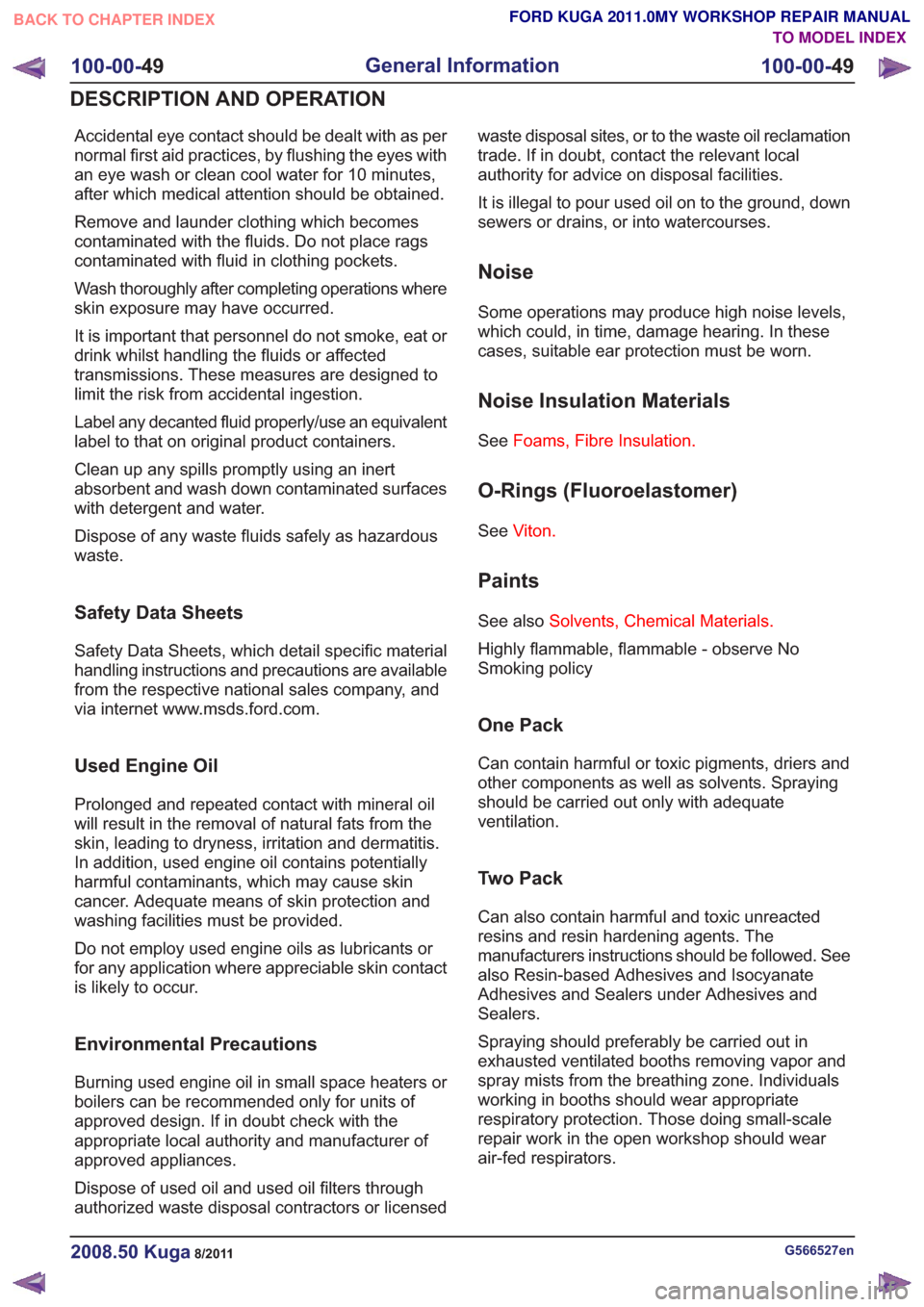
Accidental eye contact should be dealt with as per
normal first aid practices, by flushing the eyes with
an eye wash or clean cool water for 10 minutes,
after which medical attention should be obtained.
Remove and launder clothing which becomes
contaminated with the fluids. Do not place rags
contaminated with fluid in clothing pockets.
Wash thoroughly after completing operations where
skin exposure may have occurred.
It is important that personnel do not smoke, eat or
drink whilst handling the fluids or affected
transmissions. These measures are designed to
limit the risk from accidental ingestion.
Label any decanted fluid properly/use an equivalent
label to that on original product containers.
Clean up any spills promptly using an inert
absorbent and wash down contaminated surfaces
with detergent and water.
Dispose of any waste fluids safely as hazardous
waste.
Safety Data Sheets
Safety Data Sheets, which detail specific material
handling instructions and precautions are available
from the respective national sales company, and
via internet www.msds.ford.com.
Used Engine Oil
Prolonged and repeated contact with mineral oil
will result in the removal of natural fats from the
skin, leading to dryness, irritation and dermatitis.
In addition, used engine oil contains potentially
harmful contaminants, which may cause skin
cancer. Adequate means of skin protection and
washing facilities must be provided.
Do not employ used engine oils as lubricants or
for any application where appreciable skin contact
is likely to occur.
Environmental Precautions
Burning used engine oil in small space heaters or
boilers can be recommended only for units of
approved design. If in doubt check with the
appropriate local authority and manufacturer of
approved appliances.
Dispose of used oil and used oil filters through
authorized waste disposal contractors or licensedwaste disposal sites, or to the waste oil reclamation
trade. If in doubt, contact the relevant local
authority for advice on disposal facilities.
It is illegal to pour used oil on to the ground, down
sewers or drains, or into watercourses.
Noise
Some operations may produce high noise levels,
which could, in time, damage hearing. In these
cases, suitable ear protection must be worn.
Noise Insulation Materials
See
Foams, Fibre Insulation.
O-Rings (Fluoroelastomer)
SeeViton.
Paints
See also Solvents, Chemical Materials.
Highly flammable, flammable - observe No
Smoking policy
One Pack
Can contain harmful or toxic pigments, driers and
other components as well as solvents. Spraying
should be carried out only with adequate
ventilation.
Two Pack
Can also contain harmful and toxic unreacted
resins and resin hardening agents. The
manufacturers instructions should be followed. See
also Resin-based Adhesives and Isocyanate
Adhesives and Sealers under Adhesives and
Sealers.
Spraying should preferably be carried out in
exhausted ventilated booths removing vapor and
spray mists from the breathing zone. Individuals
working in booths should wear appropriate
respiratory protection. Those doing small-scale
repair work in the open workshop should wear
air-fed respirators.
G566527en2008.50 Kuga8/2011
100-00- 49
General Information
100-00- 49
DESCRIPTION AND OPERATION
TO MODEL INDEX
BACK TO CHAPTER INDEX
FORD KUGA 2011.0MY WORKSHOP REPAIR MANUAL